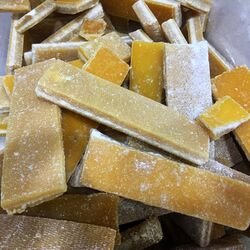Chemistry:Peen tong
Peen tong or pian tang (Chinese: 片糖; pinyin: piàntáng; Jyutping: pin3 tong4; Cantonese Yale: pintòng) and wong tong (Chinese: 黃糖; pinyin: huángtáng; Jyutping: wong4 tong4; Cantonese Yale: wòngtòng),[1] is a Chinese brown sugar and sugar candy that is used in various Chinese desserts and also consumed alone as a snack.[2][3][4] In China, it is sold in slab or brick form in one-pound packages, and occasionally as a bulk food item.[2][3][5]
Use in dishes
Peen tong is used as an ingredient in desserts, sauces and sweet soups.[1] Peen tong is sometimes used as an ingredient in nian gao, whereby the slab of peen tong is scraped and the resultant shavings are used in the dish.[3][6][5] Another method for its use in nian gao is to dissolve the peen tong in water, which is less time-consuming compared to scraping it.[3][6] It is used as an ingredient in jiandui (Chinese: 煎堆; pinyin: jiānduī; Cantonese Yale: jīndēui, a sesame ball prepared using glutinous rice flour.[7] Peen tong is also used in haptou wu (Chinese: 合桃糊; pinyin: hétáo hú; Jyutping: hap6 tou4 wu2; Cantonese Yale: hahptòu wú), a sweet Chinese walnut soup.[8]
See also
References
- ↑ 1.0 1.1 Anusasananan, L.L. (2012). The Hakka Cookbook: Chinese Soul Food from Around the World. A Philip E. Lilienthal book in Asian studies. University of California Press. p. 250. ISBN 978-0-520-27328-3. https://books.google.com/books?id=LUzMK5OFmMoC&pg=PA250. Retrieved May 28, 2017.
- ↑ 2.0 2.1 Glossary. Vegetarian Times. February 2000. p. 103. https://books.google.com/books?id=GwQAAAAAMBAJ&pg=RA1-PA103. Retrieved May 28, 2017.
- ↑ 3.0 3.1 3.2 3.3 Castella, K. (2012). A World of Cake. Storey Publishing. p. 696. ISBN 978-1-60342-446-2. https://books.google.com/books?id=Z20XOWapBCEC&pg=PT696. Retrieved May 28, 2017.
- ↑ Lee, M.T. (1987). Growing up in Chinatown--: the life and work of Edwar Lee. M.T. Lee. https://archive.org/details/growingupinchina00leem. Retrieved May 28, 2017.
- ↑ 5.0 5.1 Wong, Sharon (February 19, 2015). "Lunar New Year: Try This 'Nian Gao' Recipe". https://www.nbcnews.com/news/asian-america/lunar-new-year-try-nian-gao-recipe-n303566.
- ↑ 6.0 6.1 Weston, A. (2014). The Global Bakery: Cakes from the World's Kitchens. New Internationalist. p. 116. ISBN 978-1-78026-189-8. https://books.google.com/books?id=9jg9BAAAQBAJ&pg=PT116. Retrieved May 28, 2017.
- ↑ "Sesame Balls". January 1, 2000. https://www.vegetariantimes.com/recipes/sesame-balls.
- ↑ Mindess, Anna (June 4, 2012). "Immerse Yourself in Asian Flavors at Richmond’s Pacific East Mall". https://endpointca9003b5.chios.panth.io/bayareabites/2012/06/04/immerse-yourself-in-asian-flavors-at-richmond%E2%80%99s-pacific-east-mall/.[yes|permanent dead link|dead link}}]
Further reading
- Richardson, A.; Young, G. (2014). The Wisdom of the Chinese Kitchen: Classic Family Recipes for Celebration and Healing. Simon & Schuster. p. 204. ISBN 978-1-4391-4256-1. https://books.google.com/books?id=rb7BAwAAQBAJ&pg=PA204. Retrieved May 28, 2017.
External links


